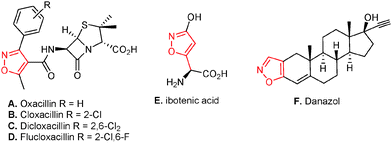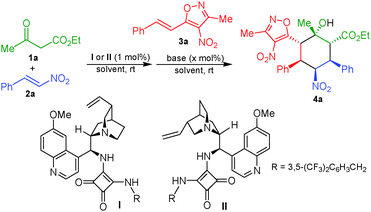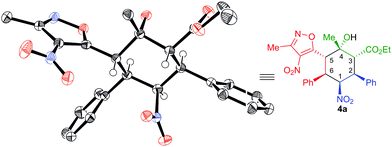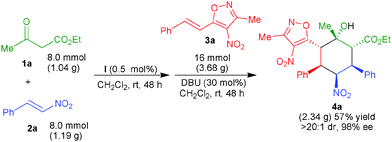 Open Access Article
Open Access ArticleCreative Commons Attribution 3.0 Unported Licence
Organocatalytic one-pot 1,4-/1,6-/1,2-addition sequence for the stereocontrolled formation of six consecutive stereocenters†
Pankaj
Chauhan
,
Suruchi
Mahajan
,
Gerhard
Raabe
and
Dieter
Enders
*
Institute of Organic Chemistry, RWTH Aachen University, Landoltweg 1, 52074 Aachen, Germany. E-mail: enders@rwth-aachen.de; Fax: +49 241 8092127
First published on 22nd December 2014
Abstract
An unprecedented stereoselective organocatalytic one-pot 1,4-/1,6-/1,2-addition sequence between β-dicarbonyl compounds, β-nitroalkenes and 4-nitro-5-styrylisoxazoles sequentially catalyzed by low loading of a squaramide catalyst and an achiral base has been developed. The protocol opens an efficient entry to isoxazole bearing cyclohexanes with six consecutive stereogenic centers including one tetrasubstituted carbon in good yields and excellent diastereo- and enantioselectivities.
Over the last ten years, asymmetric organocatalytic cascade reactions have emerged as a powerful strategy for the synthesis of complex molecules bearing multiple stereogenic centers in a highly stereocontrolled fashion.1 These one-pot organocatalytic reactions were successfully employed for the creation of cyclohexane ring systems bearing up to six stereocenters.2 Most of these triple cascade reactions are governed by more common 1,4-/1,4-/1,2 addition sequences. Another important class of addition reactions involving the enantioselective 1,6-addition to control the formation of a remote stereocenter is more challenging and less explored in comparison to the other addition variants.3 Moreover, organocatalytic cascade reactions using all possible types of addition reactions, i.e. 1,4-/1,6-/1,2-addition reactions, are not known so far. Hence we took the challenge to develop a new stereoselective one-pot organocascade sequence using 1,4-/1,6-/1,2-additions (Scheme 1).
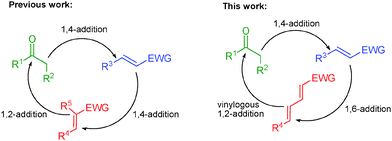 | ||
| Scheme 1 Enantioselective strategies for the construction of cyclohexane rings bearing multiple stereogenic centers. | ||
In addition, the isoxazole core is present in various important naturally occurring and synthetic bioactive molecules (Fig. 1). For example, compounds A–D are β-lactamase-resistant antibiotics,4 while an isoxazole containing natural product E is a powerful neurotoxin, which is used as a brain-lesioning agent.5 A synthetic androgenic steroid danazol D bearing an isoxazole ring suppresses the production of gonadotrophins and also has some weak androgenic effects.6 Moreover, isoxazoles serve as precursors for the synthesis of various synthetically useful organic compounds.7 Thus, the development of efficient asymmetric methods for the synthesis of isoxazole ring containing molecules can provide a new series of potentially bioactive molecules.
Recently, organo- and metal-catalyzed 1,6-additions to 4-nitro-5-styrylisoxazoles emerged as an efficient method to generate enantiopure isoxazole derivatives bearing one or two stereocenters.8,9 However, the 4-nitro-5-styrylisoxazoles remained less explored substrates in stereoselective cascade reactions.9d,g Very recently, Jørgensen's group utilized 4-nitro-5-styrylisoxazoles in trienamine-mediated asymmetric [4+2] cycloaddition reactions to afford cyclohexene products bearing three vicinal stereocenters.10 Herein we report a novel cascade reaction involving a 1,4-/1,6-/vinylogous 1,2-addition sequence to access enantiopure cyclohexane rings bearing as many as six contiguous stereogenic centers, sequentially catalyzed by low loading of a cinchona derived squaramide11 and an achiral base.
Initially, we started our investigation with a squaramide I (1 mol%) catalyzed one-pot three component reaction between ethyl acetoacetate (1a), β-nitrostyrene (2a) and 4-nitro-5-styrylisoxazole (3a) (Table 1, entry 1). However our attempt to obtain the desired cyclohexane ring failed completely, and only the formation of the Michael adduct was observed.12 We envisaged that the squaramide catalyst was not enough active to generate a nitronate anion in the corresponding Michael adduct to initiate a domino 1,6-/vinylogous 1,2-addition sequence. Thus, a sequential reaction was performed involving a squaramide I catalyzed Michael addition of the β-ketoester 1a to the β-nitrostyrene 2a, followed by the addition of 3a and a catalytic amount of DBU (20 mol%) (entry 2). To our delight, the desired cyclohexane 4a was obtained in 46% yield with excellent stereoselectivity (98% ee and >20![[thin space (1/6-em)]](https://www.rsc.org/images/entities/char_2009.gif) :
:![[thin space (1/6-em)]](https://www.rsc.org/images/entities/char_2009.gif) 1 dr). Further optimization of the reaction conditions by screening different solvents (entries 3–5) and bases (entries 6–11) showed that 30 mol% of DBU in CH2Cl2 provides a maximum yield of 62% and excellent stereoselectivity (entry 6). The use of a quinidine derived squaramide catalyst II led to the opposite enantiomer of the cyclohexane ent-4a with a similar yield, ee and dr (entry 12).
1 dr). Further optimization of the reaction conditions by screening different solvents (entries 3–5) and bases (entries 6–11) showed that 30 mol% of DBU in CH2Cl2 provides a maximum yield of 62% and excellent stereoselectivity (entry 6). The use of a quinidine derived squaramide catalyst II led to the opposite enantiomer of the cyclohexane ent-4a with a similar yield, ee and dr (entry 12).
| Entry | Base (x mol%) | Solvent | Timeb (h) | Yieldc (%) | eed (%) |
|---|---|---|---|---|---|
a Reaction conditions: 0.2 mmol of 1a, 0.2 mmol of 2a, 1 mol% of I, 0.24 mmol of 3a and x mol% of base (0.1 M in solvent).
b Time in hours for both reaction steps.
c Yield of isolated 4a after column chromatography.
d Enantiomeric excess of the major diastereomer (>20![[thin space (1/6-em)]](https://www.rsc.org/images/entities/char_2009.gif) : :![[thin space (1/6-em)]](https://www.rsc.org/images/entities/char_2009.gif) 1 dr) determined by HPLC analysis on a chiral stationary phase.
e All the reactants were added in one step.
f 2 equivalents of 3a were used.
g ee value of ent-4a synthesized by using catalyst II. 1 dr) determined by HPLC analysis on a chiral stationary phase.
e All the reactants were added in one step.
f 2 equivalents of 3a were used.
g ee value of ent-4a synthesized by using catalyst II.
|
|||||
| 1e | — | CH2Cl2 | 24 | — | — |
| 2 | DBU (20) | CH2Cl2 | 24 + 24 | 46 | 98 |
| 3 | DBU (20) | CHCl3 | 24 + 24 | 35 | 98 |
| 4 | DBU (20) | Toluene | 24 + 24 | 44 | 98 |
| 5 | DBU (30) | THF | 24 + 24 | 36 | 98 |
| 6f | DBU (30) | CH2Cl2 | 24 + 48 | 62 | 98 |
| 7f | DBN (30) | CH2Cl2 | 24 + 48 | 36 | 97 |
| 8f | TEA (30) | CH2Cl2 | 24 + 48 | Traces | n.d. |
| 9f | TBD (30) | CH2Cl2 | 24 + 48 | 29 | 98 |
| 10f | DABCO (30) | CH2Cl2 | 24 + 48 | — | — |
| 11f | Piperidine (30) | CH2Cl2 | 24 + 48 | Traces | n.d. |
| 12f | DBU (30) | CH2Cl2 | 24 + 48 | 58 | 96g |
Once equipped with optimized reaction conditions, we evaluated the substrate scope at a 0.5 mmol scale of the β-dicarbonyl compounds and the β-nitrostyrenes (Table 2). The various nitroalkenes bearing electron withdrawing and electron donating groups gave rise to the corresponding isoxazole products 4b–e in 55–67% yield and excellent stereoselectivities (>20![[thin space (1/6-em)]](https://www.rsc.org/images/entities/char_2009.gif) :
:![[thin space (1/6-em)]](https://www.rsc.org/images/entities/char_2009.gif) 1 dr and 93–99% ee). The nitroalkenes bearing a heteroaromatic group also worked well in this cascade sequence to provide the desired product 4f in 61% yield and 91% ee. Further screening of different 4-nitro-5-styrylisoxazoles bearing electron withdrawing and electron releasing substituents on the aryl ring as well as heteroaryl group provided a direct access to the corresponding cyclohexanes 4g–m in good yields and high enantioselectivities (95–99% ee). The methyl acetoacetate and acetyl acetone were also tolerated under this one-pot protocol to give rise to the respective products 4n and 4o in good yields and excellent stereoselectivities. Employing a pseudo-enantiomeric amino-squaramide catalyst II successfully led to the formation of the enantiomers of 4a–f, 4h and 4l in very good yields (51–69%) and again excellent asymmetric inductions (>20
1 dr and 93–99% ee). The nitroalkenes bearing a heteroaromatic group also worked well in this cascade sequence to provide the desired product 4f in 61% yield and 91% ee. Further screening of different 4-nitro-5-styrylisoxazoles bearing electron withdrawing and electron releasing substituents on the aryl ring as well as heteroaryl group provided a direct access to the corresponding cyclohexanes 4g–m in good yields and high enantioselectivities (95–99% ee). The methyl acetoacetate and acetyl acetone were also tolerated under this one-pot protocol to give rise to the respective products 4n and 4o in good yields and excellent stereoselectivities. Employing a pseudo-enantiomeric amino-squaramide catalyst II successfully led to the formation of the enantiomers of 4a–f, 4h and 4l in very good yields (51–69%) and again excellent asymmetric inductions (>20![[thin space (1/6-em)]](https://www.rsc.org/images/entities/char_2009.gif) :
:![[thin space (1/6-em)]](https://www.rsc.org/images/entities/char_2009.gif) 1 dr and 95–98% ee).
1 dr and 95–98% ee).
| 4/ent-4 | R1 | R2 | R3 | Yieldb (%) | eec (%) |
|---|---|---|---|---|---|
| a Reaction conditions: 0.5 mmol of 1, 0.5 mmol of 2, 1 mol% of I (entry 1–17) or II, 1.0 mmol of 3 and 30 mol% of DBU (0.1 M in CH2Cl2). b Yield of isolated product after column chromatography. c Enantiomeric excess of the major diastereomer determined by HPLC analysis on a chiral stationary phase. | |||||
| 4a | OEt | Ph | Ph | 61 | 98 |
| 4b | OEt | 4-FC6H4 | Ph | 64 | 99 |
| 4c | OEt | 4-ClC6H4 | Ph | 55 | 99 |
| 4d | OEt | 4-MeC6H4 | Ph | 63 | 93 |
| 4e | OEt | 4-MeOC6H4 | Ph | 67 | 97 |
| 4f | OEt | 2-Thienyl | Ph | 61 | 91 |
| 4g | OEt | Ph | 4-FC6H4 | 60 | 98 |
| 4h | OEt | Ph | 4-ClC6H4 | 61 | 97 |
| 4i | OEt | Ph | 3-ClC6H4 | 69 | 97 |
| 4j | OEt | Ph | 4-MeC6H4 | 73 | 99 |
| 4k | OEt | Ph | 2-MeC6H4 | 49 | 95 |
| 4l | OEt | Ph | 4-MeOC6H4 | 39 | 96 |
| 4m | OEt | Ph | 2-Thienyl | 50 | 97 |
| 4n | OMe | Ph | Ph | 58 | 97 |
| 4o | Me | Ph | Ph | 50 | 96 |
| ent-4a | OEt | Ph | Ph | 69 | 96 |
| ent-4b | OEt | 4-FC6H4 | Ph | 63 | 97 |
| ent-4c | OEt | 4-ClC6H4 | Ph | 51 | 95 |
| ent-4d | OEt | 4-MeC6H4 | Ph | 64 | 98 |
| ent-4e | OEt | 4-MeOC6H4 | Ph | 66 | 95 |
| ent-4f | OEt | 2-Thienyl | Ph | 59 | 96 |
| ent-4h | OEt | Ph | 4-ClC6H4 | 60 | 97 |
| ent-4k | OEt | Ph | 2-MeC6H4 | 50 | 96 |
The absolute configuration of the products 4a–o can be assigned as (1S), (2S), (3R), (4S), (5S) and (6R) on the basis of the X-ray crystallographic analysis of 4a (Fig. 2).13
To demonstrate the practical and preparative application of this new organocascade 1,4-/1,6-/1,2-addition sequence, we performed a gram-scale reaction between 1a, 2a and 3a using a lower loading (0.5 mol%) of the squaramide I (Scheme 2). The desired product 4a was obtained in 57% yield with unchanged ee and dr values. The enantiomeric purity could be enriched to >99% ee after a single crystallization of the product.
In conclusion, we have developed a novel 1,4-/1,6-/1,2-addition cascade sequence catalyzed sequentially by low loading of a cinchona-derived squaramide and a commercially available achiral base to afford a series of highly substituted cyclohexane derivatives bearing six consecutive stereogenic centers in good yields and excellent stereoselectivities. The enantiomeric cyclohexanes are also easily synthesized on a same level of asymmetric induction by employing a pseudo-enantiomeric squaramide catalyst. A successful gram-scale reaction documents the preparative utility of this organocascade protocol.
Support from the European Research Council (ERC Advanced Grant 320493 “DOMINOCAT”) is gratefully acknowledged. We thank BASF SE for the donation of chemicals.
Notes and references
- For selected reviews on organocatalytic domino/cascade reactions, see: (a) D. Enders, C. Grondal and M. R. M. Hüttl, Angew. Chem., Int. Ed., 2007, 46, 1570 CrossRef CAS PubMed; (b) X. Yu and W. Wang, Org. Biomol. Chem., 2008, 6, 2037 RSC; (c) C. Grondal, M. Jeanty and D. Enders, Nat. Chem., 2010, 2, 167 CrossRef CAS PubMed; (d) Ł. Albrecht, H. Jiang and K. A. Jørgensen, Angew. Chem., Int. Ed., 2011, 50, 8492 CrossRef PubMed; (e) A. Moyano and R. Rios, Chem. Rev., 2011, 111, 4703 CrossRef CAS PubMed; (f) A. Grossmann and D. Enders, Angew. Chem., Int. Ed., 2012, 51, 314 CrossRef CAS PubMed; (g) H. Pellissier, Adv. Synth. Catal., 2012, 354, 237 CrossRef CAS; (h) C. M. R. Volla, I. Atodiresei and M. Rueping, Chem. Rev., 2014, 114, 2390 CrossRef CAS PubMed ; For a recent highlight, see: ; (i) P. Chauhan and D. Enders, Angew. Chem., Int. Ed., 2014, 53, 1485 CrossRef CAS PubMed.
- For a recent review, see: (a) S. Goudedranche, W. Raimondi, X. Bugaut, T. Constantieux, D. Bonne and J. Rodriguez, Synthesis, 2013, 1909 CAS ; for selected examples, see: ; (b) D. Enders, M. R. M. Hüttl, C. Grondal and G. Raabe, Nature, 2006, 441, 861 CrossRef CAS PubMed; (c) D. Enders, M. R. M. Hüttl, Y. Runsink, G. Raabe and B. Wendt, Angew. Chem., Int. Ed., 2007, 46, 467 CrossRef CAS PubMed; (d) D. Enders, M. R. M. Hüttl, G. Raabe and J. W. Bats, Adv. Synth. Catal., 2008, 350, 267 CrossRef CAS; (e) P. G. McGarraugh and S. E. Brenner, Org. Lett., 2009, 11, 5654 CrossRef CAS PubMed; (f) Y. Wang, R.-G. Han, Y.-L. Zhao, S. Yang, P.-F. Xu and D. J. Dixon, Angew. Chem., Int. Ed., 2009, 48, 9834 CrossRef CAS PubMed; (g) K. Jiang, Z.-J. Jia, S. Chen, L. Wu and Y.-C. Chen, Chem. – Eur. J., 2010, 16, 2852 CrossRef CAS PubMed; (h) O. Baslé, W. Raimondi, M. M. Sanchez Duque, D. Bonne, T. Constantieux and J. Rodriguez, Org. Lett., 2010, 12, 5246 CrossRef PubMed; (i) D. Enders, B. Schmid and N. Erdmann, Synthesis, 2010, 2271 CrossRef CAS PubMed; (j) M. Rueping, K. L. Haack, W. Ieawsuwan, H. Sundén, M. Blanco and F. R. Schoepke, Chem. Commun., 2011, 47, 3828 RSC; (k) C. Cassani, X. Tian, E. C. Escudero-Adán and P. Melchiorre, Chem. Commun., 2011, 47, 233 RSC; (l) A. Zea, A.-N. R. Alba, A. Mazzanti, A. Moyano and R. Rios, Org. Biomol. Chem., 2011, 9, 6519 RSC; (m) D. Enders, A. Greb, K. Deckers, P. Selig and C. Merkens, Chem. – Eur. J., 2012, 18, 10226 CrossRef CAS PubMed; (n) D. Enders, G. Urbanietz, E. Cassens-Sasse, S. Keeß and G. Raabe, Adv. Synth. Catal., 2012, 354, 1481 CrossRef CAS; (o) W. Raimondi, M. M. Sanchez Duque, S. Goudedranche, A. Quintard, T. Constantieux, X. Bugaut, D. Bonne and J. Rodriguez, Synthesis, 2013, 1659 CAS; (p) X. Zeng, Q. Ni, G. Raabe and D. Enders, Angew. Chem., Int. Ed., 2013, 52, 2977 CrossRef CAS PubMed; (q) P. Chauhan, G. Urbanietz, G. Raabe and D. Enders, Chem. Commun., 2014, 50, 6853 RSC; (r) P. Chauhan, S. Mahajan, C. C. J. Loh, G. Raabe and D. Enders, Org. Lett., 2014, 16, 2954 CrossRef CAS PubMed; (s) P. Sun, C.-Y. Meng, F. Zhoua, X.-S. Li and J.-W. Xie, Tetrahedron, 2014, 70, 9330 CrossRef CAS PubMed; (t) J. I. Martínez, L. Villar, U. Uria, L. Carrillo, E. Reyes and J. L. Vicario, Adv. Synth. Catal., 2014, 355, 3627 CrossRef.
- For selected reviews and highlights on 1,6-addition reactions, see: (a) A. G. Csaký, G. de la Herrán and M. C. Murcia, Chem. Soc. Rev., 2010, 39, 4080 RSC; (b) A. T. Biju, ChemCatChem, 2011, 3, 1847 CrossRef CAS; (c) E. M. P. Silva and A. M. S. Silva, Synthesis, 2012, 3109 CrossRef CAS PubMed; (d) M. J. Lear and Y. Hayashi, ChemCatChem, 2013, 5, 3499 CrossRef CAS; (e) I. D. Jurberg, I. Chatterjee, R. Tannert and P. Melchiorre, Chem. Commun., 2013, 49, 4869 RSC ; for recent examples, see: ; (f) X. Tian, Y. Liu and P. Melchiorre, Angew. Chem., Int. Ed., 2012, 51, 6439 CrossRef CAS PubMed; (g) L. Dell'Amico, Ł. Albrecht, T. Naicker, P. H. Poulsen and K. A. Jørgensen, J. Am. Chem. Soc., 2013, 135, 8063 CrossRef PubMed; (h) W.-D. Chu, L.-F. Zhang, X. Bao, X.-Y. Zhao, C. Zeng, J.-Y. Du, G.-B. Zhang, F.-X. Wang, X.-Y. Ma and C.-A. Fan, Angew. Chem., Int. Ed., 2013, 52, 9229 CrossRef CAS PubMed; (i) L. Caruana, F. Kniep, T. K. Johansen, P. H. Poulsen and K. A. Jørgensen, J. Am. Chem. Soc., 2014, 136, 15929 CrossRef CAS PubMed; (j) K. Akagawa, N. Nishi, J. Sen and K. Kudo, Org. Biomol. Chem., 2014, 12, 3581 RSC.
- (a) R. Sutherland, E. A. P. Croydon and G. N. Rolinson, Br. Med. J., 1970, 4, 455 CrossRef CAS PubMed; (b) G. Miranda-Novales, B. E Leaños-Miranda, M. Vilchis-Pérez and F. Solórzano-Santos, Ann. Clin. Microbiol. Antimicrob., 2006, 5, 25 CrossRef PubMed.
- (a) O. Isacson, P. Brundin, P. A. T. Kelly, F. H. Gage and A. Björklund, Nature, 1984, 311, 458 CrossRef CAS; (b) A. Becker, G. Grecksch, H.-G. Bernstein, V. Höllt and B. Bogerts, Psychopharmacology, 1999, 144, 333 CrossRef CAS.
- H. C. Neumann, G. O. Potts, W. T. Ryan and F. W. Stonner, J. Med. Chem., 1970, 13, 948 CrossRef CAS.
- P. G. Baraldi, A. Barco, S. Benetti, G. P. Pollini and D. Simoni, Synthesis, 1987, 857 CrossRef CAS.
- For selected examples of 4-nitro-5-styrylisoxazoles in non-enantioselective 1,6-addition reactions, see: (a) S. Chimichi, F. D. Sio, D. Donatic, P. S. Fantoni and M. F. A. Adamo, Tetrahedron Lett., 2002, 43, 4157 CrossRef; (b) S. Bruschi, S. Suresh, L. Piras and M. F. A. Adamo, Tetrahedron Lett., 2008, 49, 7406 CrossRef PubMed; (c) M. Nagabelli and M. F. A. Adamo, Tetrahedron Lett., 2007, 48, 4703 CrossRef PubMed; (d) V. R. Konda and M. F. A. Adamo, Org. Lett., 2007, 9, 303 CrossRef PubMed; (e) F. Fini, M. Naabelli and M. F. A. Adamo, Adv. Synth. Catal., 2010, 352, 3163 CrossRef CAS; (f) D. S. Illera, S. Suresh, M. Moccia, G. Bellini, M. Saviano and M. F. A. Adamo, Tetrahedron Lett., 2012, 53, 1808 CrossRef CAS PubMed; (g) M. N. Reddy, K. G. Reddy, S. R. Krishna and E. Rajanarendar, Tetrahedron Lett., 2012, 53, 2909 CrossRef PubMed.
- For selected examples of 4-nitro-5-styrylisoxazoles in enantioselective 1,6-addition reactions, see: (a) M. Nagabelli and M. F. A. Adamo, Org. Lett., 2008, 10, 1807 CrossRef PubMed; (b) A. Baschieri, L. Bernardi, A. Ricci, S. Suresh and M. F. A. Adamo, Angew. Chem., Int. Ed., 2009, 48, 9342 CrossRef CAS PubMed; (c) Q.-L. Pei, H.-W. Sun, Z.-J. Wu, X.-L. Du, X.-M. Zhang and W.-C. Yuan, J. Org. Chem., 2011, 76, 7849 CrossRef CAS PubMed; (d) H.-W. Sun, Y.-H. Liao, Z.-J. Wu, H.-Y. Wang, X.-M. Zhang and W.-C. Yuan, Tetrahedron, 2011, 67, 3991 CrossRef CAS PubMed; (e) C. D. Fiandra, L. Piras, F. Fini, P. Disetti, M. Moccia and M. F. A. Adamo, Chem. Commun., 2012, 48, 3863 RSC; (f) J.-L. Zhang, X.-H. Liu, X.-J. Ma and R. Wang, Chem. Commun., 2013, 49, 9329 RSC; (g) R. J. Chew, Y. Huang, Y. Li, S. A. Pullarkat and P.-H. Leung, Adv. Synth. Catal., 2013, 355, 1403 CrossRef CAS; (h) X.-L. Liu, W.-Y. Han, X.-M. Zhang and W.-C. Yuan, Org. Lett., 2013, 15, 1246 CrossRef CAS PubMed.
- Y. Li, F. J. López-Delgado, D. K. B. Jørgensen, R. P. Nielsen, H. Jiang and K. A. Jørgensen, Chem. Commun., 2014, 50, 15689 RSC.
- For reviews on squaramides, see: (a) J. Alemán, A. Parra, H. Jiang and K. A. Jørgensen, Chem. – Eur. J., 2011, 17, 6890 CrossRef PubMed; (b) R. I. Storer, C. Aciro and L. H. Jones, Chem. Soc. Rev., 2011, 40, 2330 RSC.
- (a) J. P. Malerich, K. Hagihara and V. H. Rawal, J. Am. Chem. Soc., 2008, 130, 14416 CrossRef CAS PubMed; (b) H. Y. Bae, S. Some, J. S. Oh, Y. S. Lee and C. E. Song, Chem. Commun., 2011, 47, 9621 RSC; (c) Y.-F. Wang, R.-X. Chen, K. Wang, B.-B. Zhang, Z.-B. Lib and D.-Q. Xu, Green Chem., 2012, 14, 893 RSC.
- CCDC 1037530 (for 4a).
Footnote |
| † Electronic supplementary information (ESI) available. CCDC 1037530. For ESI and crystallographic data in CIF or other electronic format see DOI: 10.1039/c4cc09730k |
| This journal is © The Royal Society of Chemistry 2015 |

